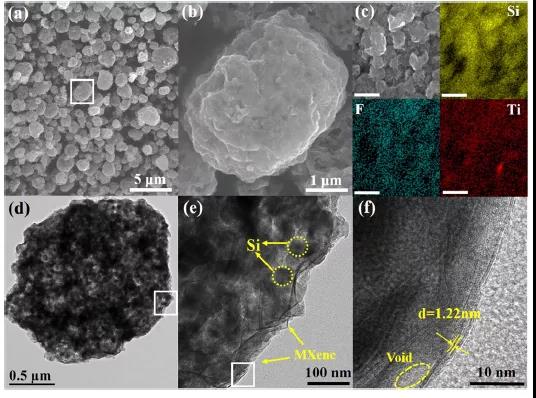Si @ MXene for high-performance lithium batteries
QQ Academic Group: 1092348845
Detailed
To meet the ever-increasing energy density requirements of portable electronic products and electric vehicles, researchers have explored a variety of electrode materials with high capacities and appropriate operating voltages for large-scale production of next-generation lithium-ion batteries (LIBs) . Among the negative electrode candidate materials, silicon is considered to be one of the most promising materials due to its highest theoretical specific capacity (4200 mAh g −1 ) and relatively low operating potential (<0.5 V vs Li / Li + ) . However, poor cycle stability severely hinders the commercial application of silicon anode materials.
Achievements
recently,Tongji University ‘s Professor Yang Xiaowei and Xiaoli Zhao Professor and Shanghai Jiaotong University ‘s Ho Yu Shi associate researcher at the internationally renowned journal ACS Applied Materials & Interfaces published entitled " MXene Frameworks the Promote at The Growth and Stability of LiF-Rich Solid-Electrolyte Interphases ON Silicon Nanoparticle Bundles " Paper. In the compressive force of the capillary, on MXene nano-pleated sheet is pretreated, by a simple thermal crosslinking reaction to further ensure the connection nanosheet MXene the mechanical performance of the structure, in order to effectively buffer the stress caused by the volume change, so MXene frame A large number of silicon nanoparticles are encapsulated. Both of these factors stabilize the electrode structure. Further, the cycle MXene the nanosheet rich fluoro group is also involved in outer frame highly compact, durable and robust enriched LiF the SEI situ generation layer, it can not only inhibit side reactions between silicon and an organic electrolyte, And can improve the structural stability of the MXene framework. Thanks to these advantages, the prepared anode hasThe high specific capacity of 1797 mA hg −1 , and after 500 cycles, the high capacity retention rate was 86.7% and the average coulombic efficiency was 99.6% . This work has laid the foundation for other electrode materials with high volume and strong volume effect.

Figure 1 Schematic diagram of Si @ MXene preparation.

Figure 2 The appearance of Si @ MXene .

Figure 3 The chemical structure of Si @ MXene .

Figure 4 The electrochemical performance of Si @ MXene .

Figure 5 The chemical structure of Si @ MXene after cycling .
in conclusion
In summary, a highly stable silicon negative electrode interlayer phase was prepared. Using MXene free volume nanosheet silicon anode to buffer stress-induced and enhanced by a covalent bond MXene frame coupling between adjacent sheets. Further, the cycle MXene abundant on nanosheet fluoro group is also involved in outer frame highly compact, durable and robust enriched LiF the SEI situ generation layer, which can suppress the decomposition of the organic electrolyte. Thanks to these advantages, the prepared anode has a high specific capacity of 1797 mA hg −1 , and after 500 cycles, the high capacity retention rate is 86.7% and the average coulombic efficiency is 99.6% . This work can also be applied to the design and preparation of SEI layers of other electrode materials with high capacity and strong volume effect .
Original link:
https://pubs.acs.org/doi/pdf/10.1021/acsami.0c01959
Source:
- Previous: AS: HF-free self-assem
- Next: MXene breakthrough: Na


 mxene academic
mxene academic
